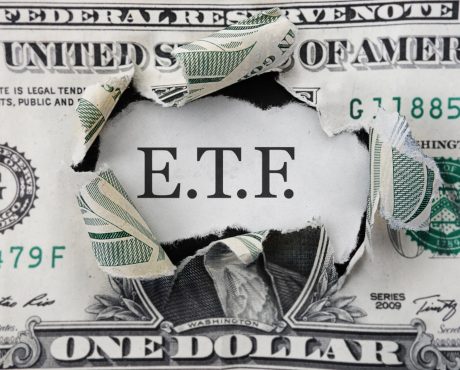Earning a Double-Digit Yield From an Exchange-Traded Fund?
Income investors love high-dividend stocks. But at the same time, we are also concerned about the risk associated with owning high-yield tickers. So today, I’m going to show you a way to collect oversized dividends without worrying about the risk in each individual high-yield company.
That is, I’m going to show you exchange-traded funds (ETFs) with oversized dividend payouts.
The most obvious reason to consider high-dividend ETFs is that they are usually well diversified. The most common concern of yield-seeking investors is dividend safety. If you own just one dividend stock and that stock suspends its dividend policy, your dividend income stream would instantly drop to zero.
An ETF, on the other hand, owns tens, if not hundreds of companies. Therefore, even if one of the companies cuts its dividend, the impact on the entire ETF’s income stream would likely be limited.
With that in mind, I have compiled a list of three high-dividend ETFs that offer substantial dividend payments at their current prices.
Note that by providing investors with diversified portfolios, these high-dividend ETFs charge a fee. When making investment decisions, investors should take into account an ETF’s expense ratio.
List of High-Yield ETFs for 2018
| ETF Name | Stock Exchange | Ticker Symbol | Dividend Yield | Management Expense Ratio |
| Global X SuperDividend ETF | NYSE Arca | SDIV | 6.96% | 0.6% |
| Vanguard Real Estate ETF | NYSE Arca | VNQ | 4.3% | 0.1% |
| InfraCap MLP ETF | NYSE Arca | AMZA | 16.6% | 1.9% |
Global X SuperDividend ETF
Global X SuperDividend ETF (NYSEARCA:SDIV) is an ETF that tracks the Solactive Global SuperDividend Index.
The fund’s strategy is very straightforward: it holds 100 of the highest dividend-paying equities around the world. All 100 stocks are equally weighted to reduce the risk associated with owning any one company. And just like the index it tracks, SDIV’s holdings are screened for dividend cuts or negative outlook on dividends on a quarterly basis. All components are rebalanced annually. (Source: “2018 Summary Prospectus,” Global X Funds, March 1, 2018.)
The ETF’s focus on high dividends has led to an impressive payout to investors. Trading at roughly $20.78 apiece, SDIV ETF offers an annual dividend yield of 6.96%. It has a management expense ratio of 0.6%.
Furthermore, by investing in equity securities around the world, the fund can help investors diversify their portfolio geographically (and hence diversify their interest rate exposure too).
More interestingly, Global X SuperDividend ETF follows a monthly distribution schedule, which is great for investors who want to use portfolio returns to cover day-to-day expenses. The fund has been paying uninterrupted monthly dividends for more than five years.
Vanguard Real Estate ETF
Other than owning stocks based entirely on yield, investors could also choose ETFs that track an industry known for producing generous dividend-payers. Real estate would be a good example of this. Typically, real estate companies are structured as real estate investment trusts (REITs). In order for a company to qualify as a REIT, it must return at least 90% of profits to shareholders through dividends.
And since REITs are usually giant landlords, they can collect a predictable stream of rental income and pass some of that to shareholders. In today’s market, REITs have become some of the highest-yielding tickers.
Vanguard Real Estate Index Fund (NYSEARCA:VNQ) aims to track the investment results of the MSCI US Investable Market Real Estate 25/50 Transition Index. The fund currently holds 186 stocks. Its three largest holdings are Vanguard Real Estate II Index Fund, American Tower Corp (NYSE:AMT), and Simon Property Group Inc (NYSE:SPG). (Source: “Vanguard Real Estate ETF (VNQ),” The Vanguard Group Inc, last accessed August 24, 2018.)
VNQ ETF pays investors a generous annual yield of about 4.3%. The fund also stands out due to its low cost. At 0.1%, Vanguard Real Estate ETF’s expense ratio is 90% lower than the average expense ratio of high-dividend ETFs with similar holdings.
InfraCap MLP ETF
Another sector known for having many high yielders is midstream energy. These companies are often structured as master limited partnerships, or MLPs. They run a relatively stable business by operating energy pipelines and storage terminals. Plus, their MLP status requires them to distribute most of their available cash to investors.
InfraCap MLP ETF (NYSEARCA:AMZA) is an ETF that specializes in MLPs. It also has an emphasis on providing high current income. Right now, the fund pays investors monthly distributions of $0.11 per share, which translates to an annual yield of 16.6%.
Note, that unlike most high-dividend ETFs that passively track an index, InfraCap MLP ETF is actively managed. The selection of securities and weightings in its portfolio are based on company-level fundamental analysis and technical factors. As a result, the fund charges a higher management fee, which comes out to 1.9% annually.
